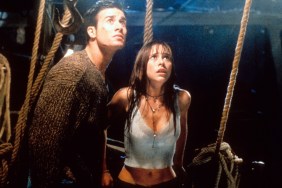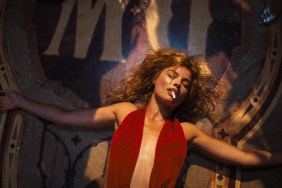Actor Emile Hirsch went to gruesome lengths to prepare for his role in acclaimed horror film The Autopsy of Jane Doe
Rightly cited by audiences and critics alike as one of the scariest horror films in years, director André Øvredal’s malevolent and macabre supernatural mystery The Autopsy of Jane Doe (read our glowing review here) is a movie that trades on our innate fear of death. But not just death. The gruesome realities of what happens after death, when our bodies, our machines that we drive during our brief tenure on the planet, end up on a slab and are subject to untold indignities. The movie exploits that revulsion before slowly, surely twisting into even weirder realms.
The film stars beloved British actor Brian Cox (Manhunter, The Ring) and Emile Hirsch (Killer Joe, Into the Wild) as father and son coroners who are trying to find cause of death for a young woman (Olwen Kelly) who ends up on their table late one dark, stormy night. Seemingly perfect, the pair open up the corpse only to discover that everything they thought they knew about death might just not apply to this subject.
Though amply revolting, it’s the performances and dialogue that really draw you in to the film, with Hirsch matching the elder actor every step of the way as a young man who adores his father and, despite his own desires to find his own way in life, refuses to leave the old man’s side. For better or for worse.
This writer is a big fan of Hirsch’s work and due to my enthusiasm for The Autopsy of Jane Doe, I jumped at the chance to speak to the man, a lively chat in which the actor reveals the shocking steps he took to give his performance authenticity. Enjoy…
ComingSoon.net: As a fan of horror, you’re always looking for that film that “gets” you, that makes you feel like a terrified 12-year-old kid. Jane Doe got me. But what I really loved was that chemistry between father and son onscreen that you and Brian so deftly purvey. Did you have much time to workshop that relationship in pre-production?
Emile Hirsch: Well, we had about two weeks before we started shooting to prepare, but I think that one of main reasons Brian and I clicked was that our personalities were very compatible. We both liked the idea of these characters being quiet professionals. But we’re both also goofy and joker types. That was our bonding right there. We respected each other, but we had this shared sense of humor that I think you see in the film.
CS: And there is a kind of humor in the film for sure…
Hirsch: Yes, I think so. But there’s a very, very dark tone.

CS: This is your first horror film, correct?
Hirsch: Yeah, for sure.
CS: Even though you are aware of the illusions, was it strange or upsetting to be around all those bloody, prosthetic special effects?
Hirsch: Well, I actually went to the LA county morgue before shooting, so I had seen hundreds of bodies and had to sign all these forms that said I wouldn’t sue them if I got Ebola, that kind of thing.
CS: Wow, really?
Hirsch: Yeah. And that was disturbing. I saw five or six active autopsies. I saw an overweight African American woman be chopped into tiny pieces and I saw a homeless white dude be completely gutted and have his brain stem clipped off, stuff where even to this day you know, almost two years later, is still super fresh in my mind. I was so rocked by that experience and it really altered the way I perceived being alive. But it was still strangely life affirming in that it hammers home the point that we’re all here so briefly. So it was a weird mix of terror and inspiration and I think that’s what the movie taps into. I think the main reason that you thought it was that scary is that it’s a horror movie where you look into the abyss of death in a different way. I was scared when I went to the morgue and that was without the supernatural element. Then when you combine the clinical with the supernatural, I think that’s a really potent combo.
CS: When you were there, looking at this stuff did you ever get past the revulsion?
Hirsch: No, I didn’t because I was only in there for three hours on the tour, so I was in shock the whole time. So when you’re watching an autopsy – and they go fast, like 20 minutes each and they’re not that gentle, it’s not like surgery when they’re worried they might kill the patient – it’s overwhelming. Though I did try to hone in on the technical details and took note of the casual way the workers treated the bodies, like they were bags of meat. Not in a disrespectful way, but they were just so used to this. And they need to be away from it or you’d go insane. They can’t be like, “Oh hey, look it’s Uncle Joe!” If you got into the head-space and grief of every death, you simply could not handle it. I was told that every so often, however, a worker spins-out and just can’t take it. It does happen.
CS: Part of the beauty and terror of the film is watching these two professionals unraveling as the mystery unravels – when they lose control, we stop “trusting” the movie…
Hirsch: Yes. And one of the things I appreciated about how Andre let Brian and I portray our characters is that I sort of felt that there was a downbeat muted quality to the performances. That’s so rare today. That subtlety…

CS: And the conversational way the film plays out, which was also refreshing.
Hirsch: Yeah, something almost M*A*S*H-like.
CS: Or Quincy.
Hirsch: Yeah, exactly.
CS: Let’s talk about Olwen as Jane Doe. When people call this film a “two-hander,” I have to correct them and cite it as a three…
Hirsch: Yeah, she was incredible. She was more of a “method actor” than Brian and I by far. She wouldn’t talk to us at all. Not to be mean, but she just didn’t want us to see her as Olwen. She wanted us to see her as Jane Doe. She was so pointed about it I almost wonder if Andre told her to be like this. But I did forget. Sometimes I tried to say hello to her and she might sort of kind of give me a little nod. We talked so little, I almost forget she spoke English. She was so quiet and still and you know, she suffered a lot of uncomfortable positions because she was naked, but worse, she was on this cold marble slab. You know how when you sit on marble it freezes your ass and freezes your bones? That’s what this was except she had no clothes on. It was really cold for her. They were trying to heat up the marble. She was on the edge and she was just like a soldier who braved it all.
CS: I think this film would make a brilliant stage play.
Hirsch: Yeah… you know, that’s a great point. You could get even more in depth with the characters and get even scarier… yeah, that would be really cool.
CS: You could really play with sound and light and make it totally immersive…
Hirsch: Yeah. That would be incredibly visceral. This is a great idea.
CS: Speaking of plays, I saw a Toronto company mount a production of Killer Joe recently and marveled that the actor playing Chris was actually playing you playing Chris from the film!
Hirsch: (laughs) Really? Michael Shannon was Chris first on stage and I didn’t touch Shannon because he’s so good. I remember when we did that and I was just thinking that it was the most out there play. I was like a stereo in some scenes and I just turned the volume alllllll the way up to 11 and was like “Fuuuuckkkkkk iiiitttttttt!” (laughs). Then I watched it back and I was like, Holy smokes, that was pretty big! (laughs).









